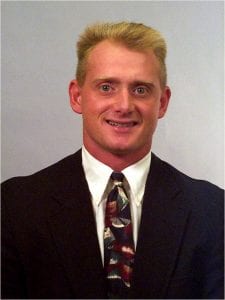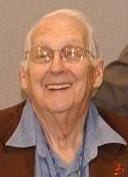Dr. Hofstetter was born in Windsor Mills, Ohio, on September 10, 1914, to immigrant parents, Kaspar and Augusta (Kresin) Hofstetter. His father, a dairy farmer, was born in Switzerland, and his German mother was born in West Prussia, now a part of Poland. Dr. Hofstetter had three brothers and seven sisters. He was eighth in the birth order, “Henry the Eighth,” as he sometimes pointed out. Dr. Hofstetter was raised on the family farm near Huntsburg in northeastern Ohio. Growing up in a large family may have a played a role in the development of his remarkable organizational skills. He once recalled that neatness, tidiness, and orderliness were paramount at all times in the Hofstetters’ home. There was one hammer in the house used by 13 people, but it was always put back in its place and easily found when needed. Dr. Hofstetter had no clear career plans in high school, and the Great Depression appeared to make farming a good choice, although the crippling of his left hand by polio at the age of 16 may have steered him away from farming. He wrote the words to the school song for his high school and was voted “Most Likely to Succeed” in his graduating class of 11 students.
With the help of an older sister, Dr. Hofstetter attended Western Reserve University for two years and Kent State University for a summer, after which he obtained an Ohio teacher’s certificate. Then, for three years, he taught all eight grades in a one-room country school in Middlefield, Ohio, where he also performed janitorial duties. His students thought that he had eyes in the back of his head when he wrote on the blackboard in class; what they didn’t realize was that he could see their reflections in the glass covering the portrait of George Washington that hung over the chalkboard. At a 50-year class reunion, many of these students recited to Dr. Hofstetter the poems he had written for them to deliver at Christmas performances.
While teaching in Middlefield, he lived with one of his older sisters and her husband, a jeweler, who also fitted spectacles and encouraged Dr. Hofstetter to consider optometry as a career. Dr. Hofstetter then entered The Ohio State University, receiving a BS degree in optometry in 1939. He received an MS and PhD in physiological optics at Ohio State in 1940 and 1942, respectively, under Dr. Glenn Fry. He was Dr. Glenn Fry’s first graduate student and also the first recipient of a PhD degree granted by a graduate program in physiological optics in any optometry school or college. It was at Ohio State that he met his wife, Frances Jane Elder. They married on July 5, 1941, in Pasadena, California, her home state. Frieda Shute, the sister with whom Dr. Hofstetter lived while teaching elementary school, also attended optometry school at Ohio State after she was widowed. She graduated in 1946 and practiced for many years in Middlefield.
Dr. Hofstetter’s thesis research was a haploscopic investigation of accommodation and convergence relationships. After completion of his PhD, Dr. Hofstetter accepted a teaching position at Ohio State. He later recalled, in his typically humble fashion, that he became valuable to the school because he was classified 4-F by his physical handicaps and would probably never be drafted for World War II. During the successive depletion of able-bodied students and faculty from the classroom during the war, he had the unique opportunity to teach almost every course in the curriculum to the few remaining students.
In his six years as a faculty member at Ohio State, Dr. Hofstetter advanced from instructor to associate professor. In January 1949, he became dean of the Los Angeles College of Optometry (now the Southern California College of Optometry at Marshall B. Ketchum University). Some of the adjectives used to describe his deanship there were business-like, organized, and efficient.
In 1951, Indiana optometrists were successful in their efforts to convince the Indiana legislature to establish an optometry school at Indiana University in Bloomington. The Indiana University administration wanted a person with excellent credentials to head the new program, and Dr. Hofstetter was recruited for the job. Though he wasn’t seeking to leave Los Angeles, he was convinced to take the position of director of the Division of Optometry at Indiana University starting in 1952. The curriculum, which he designed for the optometry students entering in the fall of 1953, reflected his educational and teaching experiences and philosophies in that it included a broad-based scientific background in optics, visual physiology, and related topics rather than a purely applied-optics approach. One of his early priorities was the establishment of a graduate program in physiological optics, which admitted its first students in 1954. His years guiding the Indiana University program also saw the construction of its current building and the development of an optometry branch library. Dr. Hofstetter served as head of the optometry program until 1970, when he returned to the classroom full-time. He became the Rudy Professor of Optometry in 1974. He formally retired in 1980 but remained very active in optometric organizations and writing. Dr. Hofstetter advised 15 MS and 11 PhD students at Indiana University.
Dr. Hofstetter authored four textbooks, including Optometry: Professional, Legal, and Economic Aspects (1948, reprinted 1964) and Industrial Vision (1956), and more than 500 scientific papers. He co-edited five editions of the Dictionary of Visual Science, with the fifth edition, now titled Dictionary of Visual Science and Related Clinical Terms, published in 2000. He published on several topics, including accommodation, binocular vision, color vision, visual optics, refractive errors, occupational vision, presbyopia, strabismus, optometric education, and international optometry. He also wrote extensively for the newsletter of the Optometric Historical Society and served as one of its editors for more than 30 years. He felt strongly that optometrists should know more about their history because optometry is a discipline with as noble and pervasive a heritage as any, and because historical study shows optometry’s centuries-long existence. Its development from a mercantile trade to its present academic and professional stature shows a truly proud history that includes many prominent and accomplished personalities.
He served many dozens of optometric, scientific, university, and community committees and organizations. He was president of the Association of Schools and Colleges of Optometry, the American Optometric Association, and the Optometric Historical Society. He served on the Bloomington, Indiana hospital board for six years. He was a member of Rotary International for 40 years, served as president of the Bloomington Rotary Club, and visited hundreds of rotary clubs worldwide. He was a consultant to the National Academy of Science, the United States Public Health Service, the Highway Research Board, the United States Air Force, and the National Science Foundation.
Because of his interest in international optometry, his extensive travels, and his work in numerous professional and scientific organizations, Dr. Hofstetter was known by optometrists worldwide. While at Indiana University, he took three sabbaticals to study modes of optometry practice and the status of optometric education in South Africa, Australia, and Europe. He carried out regular correspondence with optometrists and optometric leaders from all over the world, providing them guidance and encouragement. In 1991, he was recognized as the International Optometrist of the Year by the International Optometric and Optical League. In 1999 he received the first Distinguished Service Award from the World Council of Optometry. That same year, he was inducted into the National Optometry Hall of Fame. Some of his other awards and recognitions include five honorary doctorate degrees, the American Academy of Optometry’s highest award, the Prentice Medal, the American Optometric Association’s Apollo Award, the American Optometric Association’s Distinguished Service Award, the Indiana Optometric Association’s Distinguished Service Award, and the Orion Award from the Armed Forces Optometric Society.
 Dr. Min was born in Seoul, South Korea and immigrated to the United States at age 3. During his youth, he lived in Los Angeles, Texas, Philadelphia, and Wheelersburg, Ohio, where he attended high school.
Dr. Min was born in Seoul, South Korea and immigrated to the United States at age 3. During his youth, he lived in Los Angeles, Texas, Philadelphia, and Wheelersburg, Ohio, where he attended high school.







